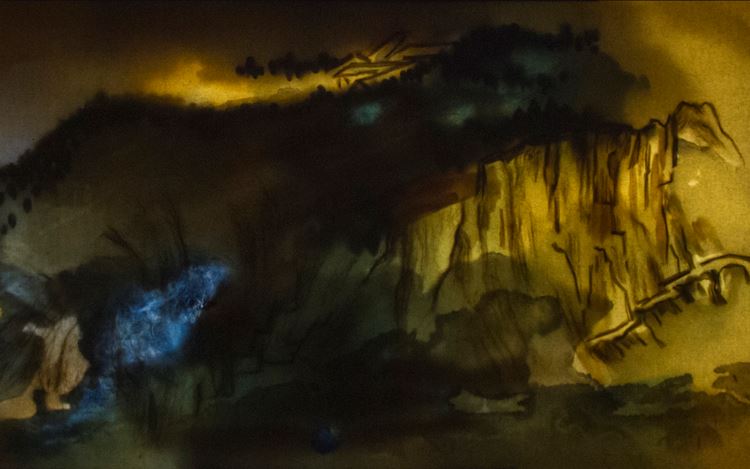
Xu Bing, Background Story: Twilight of Xiqiao (2020) (detail). Installation/ multiple materials attached to frosted glass panel. 100 cm x 250 cm. Courtesy He Art Museum.
Introduction to Thematic Exhibition
The exhibition attempts to develop on two aspects: “Mundane World” and the things from said world. “Mundane World” or the human world, includes the space inhabited by human beings, and time, material, energy, speed, etc. The rest of it, the tangible items like landscapes make up the things from the Mundane World. It is a study of how tangible “things” develop through the nebulous nature of the “Mundane World” and the resulting issues of production, consumption, ecology, etc. In the context of the on-going public health threat, this topic has become more specific and realistic.
Introduction to the Thematic Exhibition Sections
Experience All Things
"All things" is the broad concept of all objects and beings, including the unpredictable enigma of nature and its inexhaustible energy. Experience is both the starting and end point for humans, gaining greater perception through a process of coming in contact with these various objects and beings. In the field of contemporary art, material mediums are of paramount importance. Our interaction with nature is constructed and reconstructed by exploring, utilizing the quality and energy of materials, as well as by accumulated creative experiences. Artistic experiments extend beyond mere experience, they record the direction of our understanding of natural materials, reveal the limitations of the visual experience, and deconstruct, while transforming the original form of materials. As artists "experience all things," this gradually shapes their perceptions, thoughts, and transformations of art in material and visual culture, and brings out a transcendental visual tension.
Doctrine for "Sole" Material Development
Modern development directly impacts all
fields of human life. Humanity’s infinite worship of energy on an
epistemological level and the overexploitation of natural resources have
led to resource depletion. This depletion lays the foundation, on which
the doctrine of "sole" material development is built. It represents the
rampant destruction of the Earth's natural ecology and lack of control
as a result of social production, consumer culture, and personal
desires. Hence, through an artist's anxious expressions of the
ecological changes, they are alerting the world and protecting the
environment. Perhaps this exhibition will give insight to the profound
social problems that affect the world through the artists' expressive
displays. Although this explanation and criticism involve social systems
and realistic demands of them, the exhibit tries to arouse the
audience's awareness of the crisis of human survival and the sense of
reverence for nature.
Mundane Canteen
In traditional Chinese history, Shunde is
one of the most culinarily rich cities. Eating is a human instinct and
is closely related to our body and survival. The food chain can also be
one of the indicators for measuring the diversity of natural ecology.
The change and integration of food culture has not only become a major
source of national and religious taboos, but also reflects the conflicts
in social history, events, power, and class. The participating artists
transform this indispensable sustenance into a creative resource, build a
metaphorical canteen in the exhibition space for communicating the
deeper themes of cooking, and trace the food-related memories about life
based on the traditional diet and cultural experience from different
countries and ethnic groups. Food art re-interprets the basis of our
existence and extends it to the realm of material culture. This art is
formed through experiences of cooking, consuming, desire, and the
diverse eating cultures of the artists and audiences, thereby presenting
the symbiotic relationship between our living environment and our food
systems.
Introduction to the Collection Exhibition
Milieu in Change: He Art Museum Chinese Modern Collection Exhibition
Curator: Hu Bin
Assistant Curator: Lai Zhiqiang
Chinese art and culture have formed a unique model in the relationship between humans and nature, as well as humans and society. Since modern times, this kind of model has undergone new changes through the process of cultural inheritance. As the intellectual Liang Qichao stated, "The criticism of painting in today's context, it is a state of milieu in change." Hence, taking "Milieu in Change" as the theme of the modern art exhibition of the museum's collection aims to highlight internal extension and timely adjustments in thinking towards all things concerning Chinese art in the 20th century, particularly in the context of exchanging discourses between China and the West. Moreover, the rise of the notion of "the heavenly way" in the context of the "new world," brings forth the changes on the social structure, culture and visual system in a much broader spectrum. This exhibition attempts to present the concepts of Chinese painting that have been violently involved in the global culture in a state of transition from tradition to modernity. This exhibition can be considered as a way of tracing the path China has taken, as well as a reference for critical reflections on the present.
About the exhibition
Dates: 2020.10.01-2021.03.31
Chairman of Exhibition: He Jianfeng
Chief Curator: Feng Boyi
Curators: Hu Bin, Wang Xiaosong, Liu Gang, Shao Shu
Assistant Curators: Yang Qing, Gou Xianxu, Yuan Zhao, Lai Zhiqiang, Wang Qi
Venue: He Art Museum
Address: 6 Yixing Rd, Shunde District, Guangdong, China
Courtesy of He Art Museum, for further information please visit www.hem.org or contact +86 136 0266 4400.




























